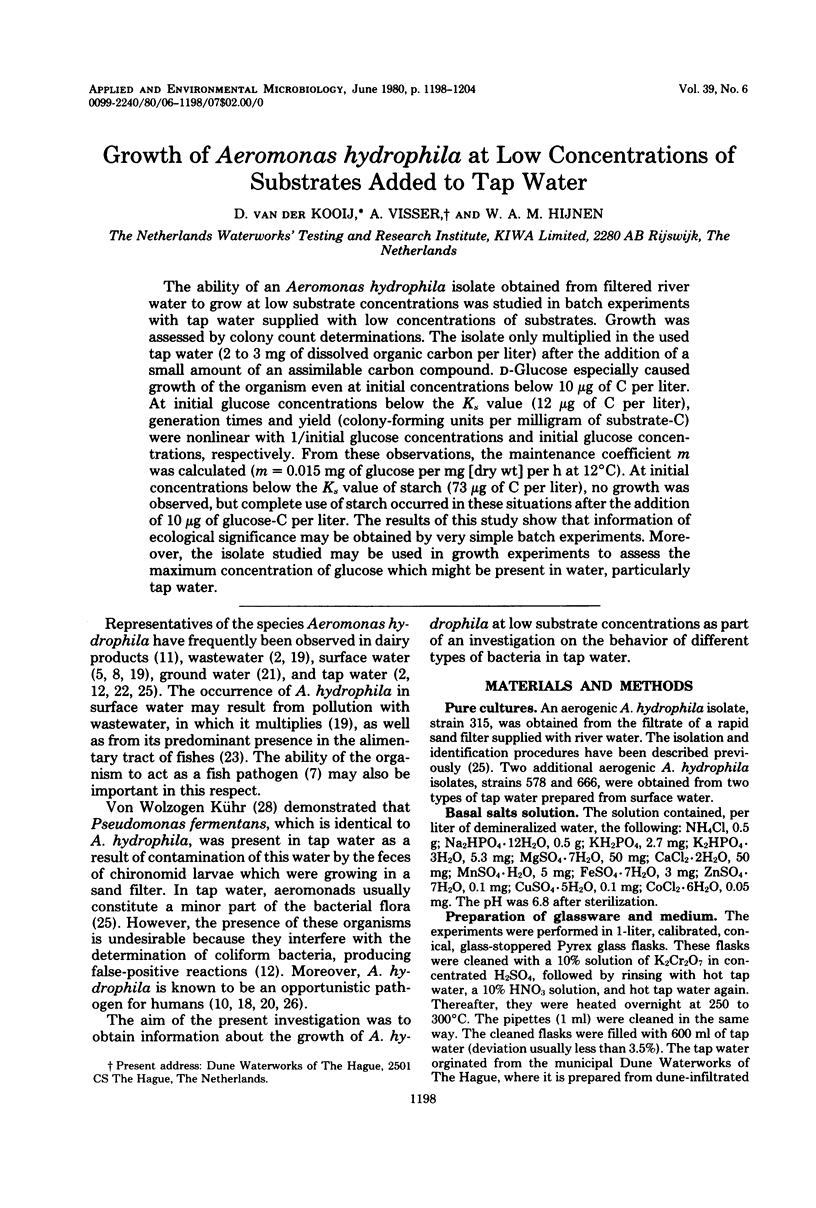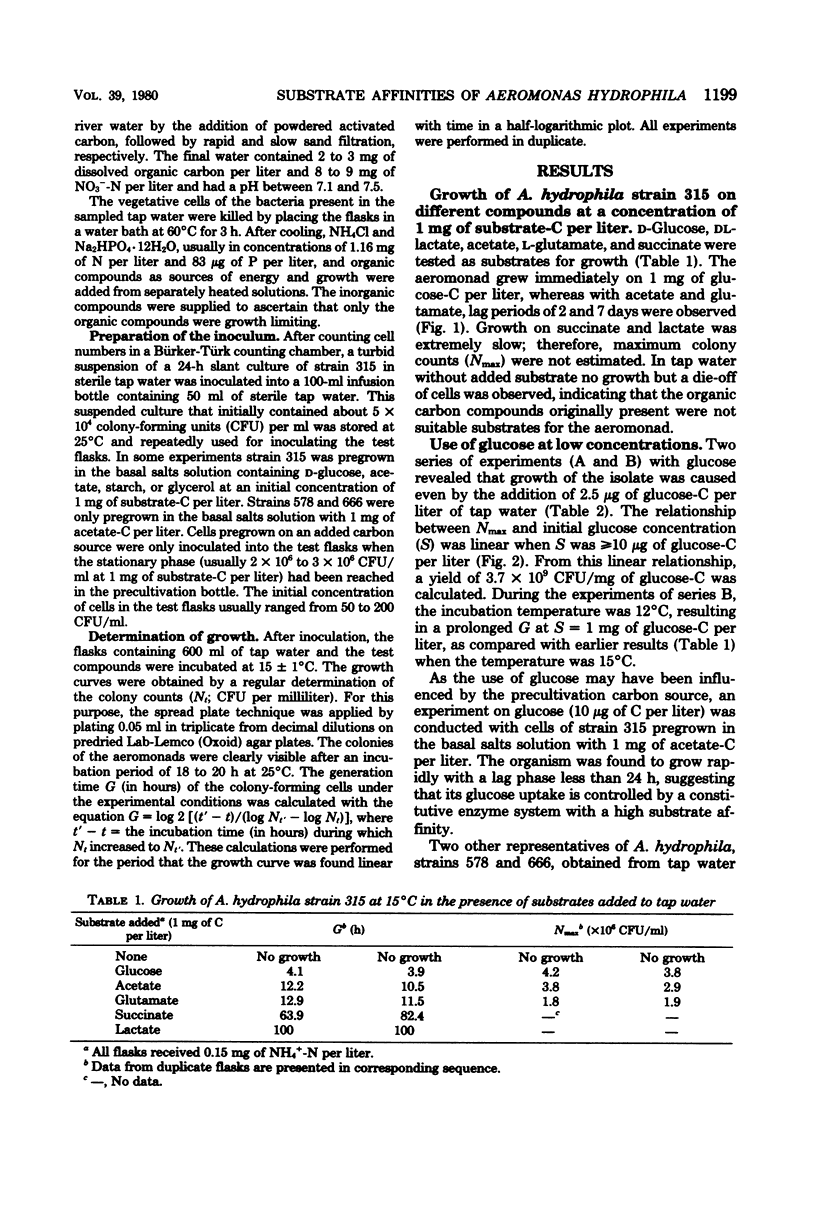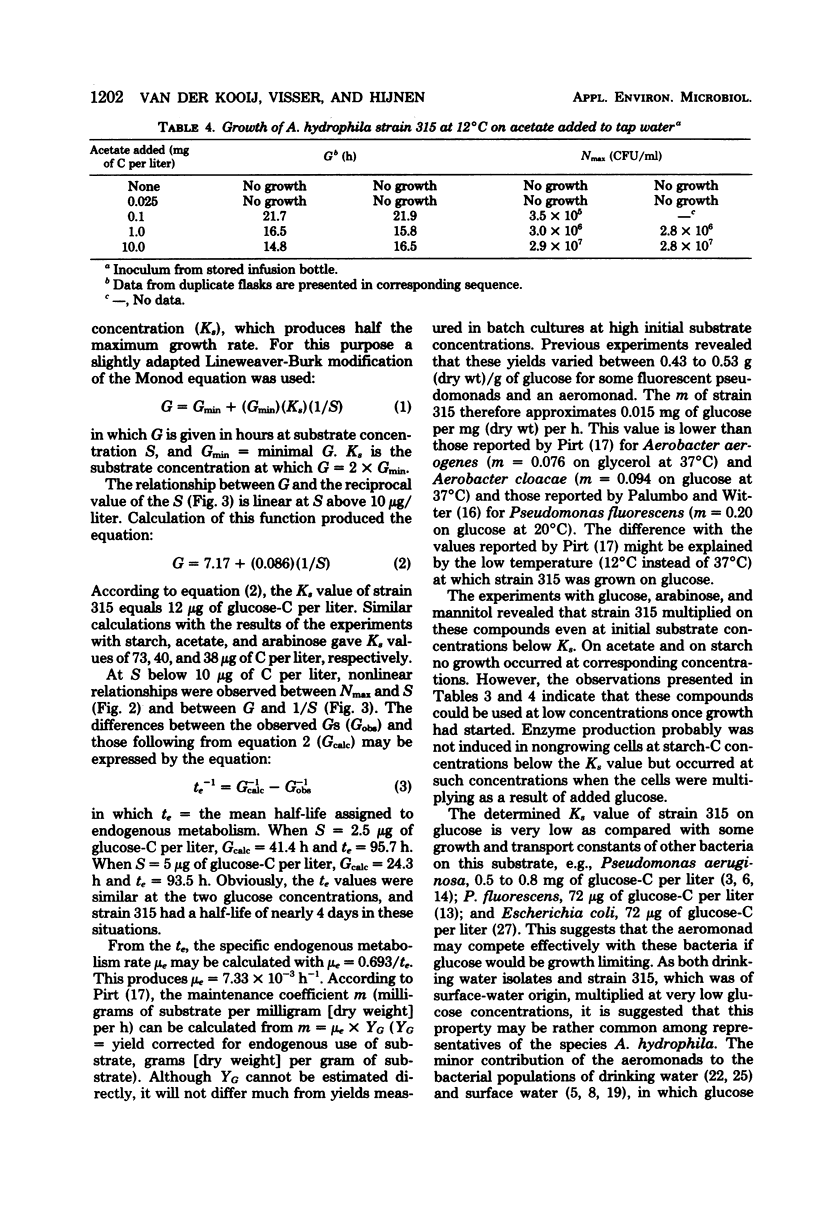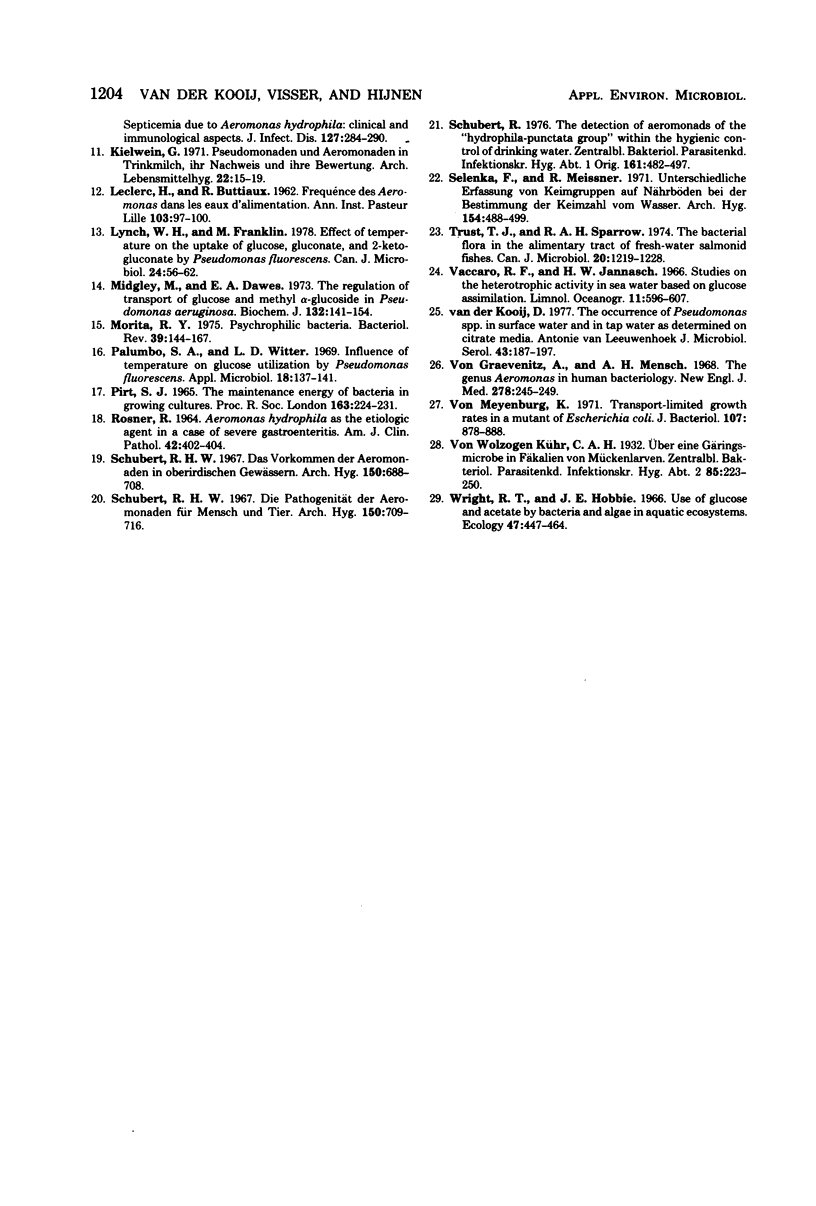Abstract
The ability of an Aeromonas hydrophila isolate obtained from filtered river water to grow at low substrate concentrations was studied in batch experiments with tap water supplied with low concentrations of substrates. Growth was assessed by colony count determinations. The isolate only multiplied in the used tap water (2 to 3 mg of dissolved organic carbon per liter) after the addition of a small amount of an assimilable carbon compound. d-Glucose especially caused growth of the organism even at initial concentrations below 10 μg of C per liter. At initial glucose concentrations below the Ks value (12 μg of C per liter), generation times and yield (colony-forming units per milligram of substrate-C) were nonlinear with 1/initial glucose concentrations and initial glucose concentrations, respectively. From these observations, the maintenance coefficient m was calculated (m = 0.015 mg of glucose per mg [dry wt] per h at 12°C). At initial concentrations below the Ks value of starch (73 μg of C per liter), no growth was observed, but complete use of starch occurred in these situations after the addition of 10 μg of glucose-C per liter. The results of this study show that information of ecological significance may be obtained by very simple batch experiments. Moreover, the isolate studied may be used in growth experiments to assess the maximum concentration of glucose which might be present in water, particularly tap water.
Full text
PDF






Selected References
These references are in PubMed. This may not be the complete list of references from this article.
- Botzenhart K., Röpke S. Lebensfähigkeit und Vermehrung von Pseudomonas aeruginosa in anorganischen Salzlösungen. Arch Hyg Bakteriol. 1971 Apr;154(5):509–516. [PubMed] [Google Scholar]
- Clark J. A., Pagel J. E. Pollution indicator bacteria associated with municipal raw and drinking water supplies. Can J Microbiol. 1977 Apr;23(4):465–470. doi: 10.1139/m77-068. [DOI] [PubMed] [Google Scholar]
- Eagon R. G., Phibbs P. V., Jr Kinetics of transport of glucose, fructose, and mannitol by Pseudomonas aeruginosa. Can J Biochem. 1971 Sep;49(9):1031–1041. doi: 10.1139/o71-151. [DOI] [PubMed] [Google Scholar]
- Fliermans C. B., Gorden R. W., Hazen T. C., Esch G. W. Aeromonas distribution and survival in a thermally altered lake. Appl Environ Microbiol. 1977 Jan;33(1):114–122. doi: 10.1128/aem.33.1.114-122.1977. [DOI] [PMC free article] [PubMed] [Google Scholar]
- Guymon L. F., Eagon R. G. Transport of glucose, gluconate, and methyl alpha-D-glucoside by Pseudomonas aeruginosa. J Bacteriol. 1974 Mar;117(3):1261–1269. doi: 10.1128/jb.117.3.1261-1269.1974. [DOI] [PMC free article] [PubMed] [Google Scholar]
- Hansen J. C., Bonde G. J. Aeromonas hydrophila (s. liquefaciens) some mulig årsag til furunkulose hosål. Nord Vet Med. 1973 Mar;25(3):121–130. [PubMed] [Google Scholar]
- Hazen T. C., Fliermans C. B., Hirsch R. P., Esch G. W. Prevalence and distribution of Aeromonas hydrophila in the United States. Appl Environ Microbiol. 1978 Nov;36(5):731–738. doi: 10.1128/aem.36.5.731-738.1978. [DOI] [PMC free article] [PubMed] [Google Scholar]
- LECLERC H., BUTTIAUX R. [Incidence of Aeromonas in drinking water]. Ann Inst Pasteur (Paris) 1962 Jul;103:97–100. [PubMed] [Google Scholar]
- Lynch W. H., Franklin M. Effect of temperature on the uptake of glucose, gluconate, and 2-ketogluconate by Pseudomonas fluorescens. Can J Microbiol. 1978 Jan;24(1):56–62. doi: 10.1139/m78-010. [DOI] [PubMed] [Google Scholar]
- Midgley M., Dawes E. A. The regulation of transport of glucose and methyl alpha-glucoside in Pseudomonas aeruginosa. Biochem J. 1973 Feb;132(2):141–154. doi: 10.1042/bj1320141. [DOI] [PMC free article] [PubMed] [Google Scholar]
- Morita R. Y. Psychrophilic bacteria. Bacteriol Rev. 1975 Jun;39(2):144–167. doi: 10.1128/br.39.2.144-167.1975. [DOI] [PMC free article] [PubMed] [Google Scholar]
- Palumbo S. A., Witter L. D. Influence of temperature on glucose utilization by Pseudomonas fluorescens. Appl Microbiol. 1969 Aug;18(2):137–141. doi: 10.1128/am.18.2.137-141.1969. [DOI] [PMC free article] [PubMed] [Google Scholar]
- Pirt S. J. The maintenance energy of bacteria in growing cultures. Proc R Soc Lond B Biol Sci. 1965 Oct 12;163(991):224–231. doi: 10.1098/rspb.1965.0069. [DOI] [PubMed] [Google Scholar]
- ROSNER R. AEROMONAS HYDROPHILA AS THE ETIOLOGIC AGENT IN A CASE OF SEVERE GASTROENTERITIS. Am J Clin Pathol. 1964 Oct;42:402–404. doi: 10.1093/ajcp/42.4.402. [DOI] [PubMed] [Google Scholar]
- Schubert R. H. Das Vorkommen der Aeromonaden in oberirdischen Gewässern. Arch Hyg Bakteriol. 1967 Mar;150(7):688–708. [PubMed] [Google Scholar]
- Schubert R. H. Die Pathogenität der Aeromonaden für Mensch und Tier. Arch Hyg Bakteriol. 1967 Mar;150(7):709–716. [PubMed] [Google Scholar]
- Schubert R. Der Nachweis von Aeromonaden der "Hydrophila-Punctata-Gruppe" im Rahmen der hygienischen Trinkwasserbeurteilung. Zentralbl Bakteriol Orig B. 1976 Mar;161(5-6):482–497. [PubMed] [Google Scholar]
- Selenka F., Meissner R. Unterschiedliche Erfassung von Keimgruppen auf Nährböden bei der Bestimmung der Keimzahl im Wasser. Arch Hyg Bakteriol. 1971 Apr;154(5):488–499. [PubMed] [Google Scholar]
- Trust T. J., Sparrow R. A. The bacterial flora in the alimentary tract of freshwater salmonid fishes. Can J Microbiol. 1974 Sep;20(9):1219–1228. doi: 10.1139/m74-188. [DOI] [PubMed] [Google Scholar]
- Von Graevenitz A., Mensch A. H. The genus aeromonas in human bacteriology report of 30 cases and review of the literature. N Engl J Med. 1968 Feb 1;278(5):245–249. doi: 10.1056/NEJM196802012780504. [DOI] [PubMed] [Google Scholar]
- van der Kooij D. The occurrence of Pseudomonas spp. in surface water and in tap water as determined on citrate media. Antonie Van Leeuwenhoek. 1977;43(2):187–197. doi: 10.1007/BF00395673. [DOI] [PubMed] [Google Scholar]
- von Meyenburg Kaspar Transport-limited growth rates in a mutant of Escherichia coli. J Bacteriol. 1971 Sep;107(3):878–888. doi: 10.1128/jb.107.3.878-888.1971. [DOI] [PMC free article] [PubMed] [Google Scholar]


